The Story
Late in the winter of 2022, I decided to get out of my home and do a little traveling in a warmer clime. I have been working on an online herbal database (more on this in a future newsletter) and wanted to stop writing about plants and see them instead. I decided to visit the Venus flytrap, a plant I have long wanted to see in its native habitat. I started contacting botanically inclined friends who put me in touch with other plant lovers, and a plan was formed.
These plants grow in a restricted 70 mile region near the coast of North and South Carolina, a place I had only briefly previously visited.
I purchased a new plant identification book for the region and set my goal for visiting in mid-April. I also made plans to explore the area with my good friend and fellow plant admirer, CoreyPine Shane.
During those 9 days, I saw 9 different carnivorous plants in 5 genera and 3 families. This was way more than I expected, making it a plantful botanical adventure.
What is a Pocosin?
I saw most of these carnivorous plants in an ecosystem called a pocosin.
A pocosin is a type of nutrient-poor wetland, though it goes through seasonal dry spells. It is made up of poorly drained, acidic, sandy soil. The lack of available nutrients in the soil gave rise to the many carnivorous plants that live there. Unfortunately, the pocosin ecosystem has dramatically decreased over the last 40 years due to human alterations.
I was expecting to find these plants in the type of soggy sphagnum bogs I am familiar with, yet, the region looked more like a savannah, with mostly dry ground and sand.
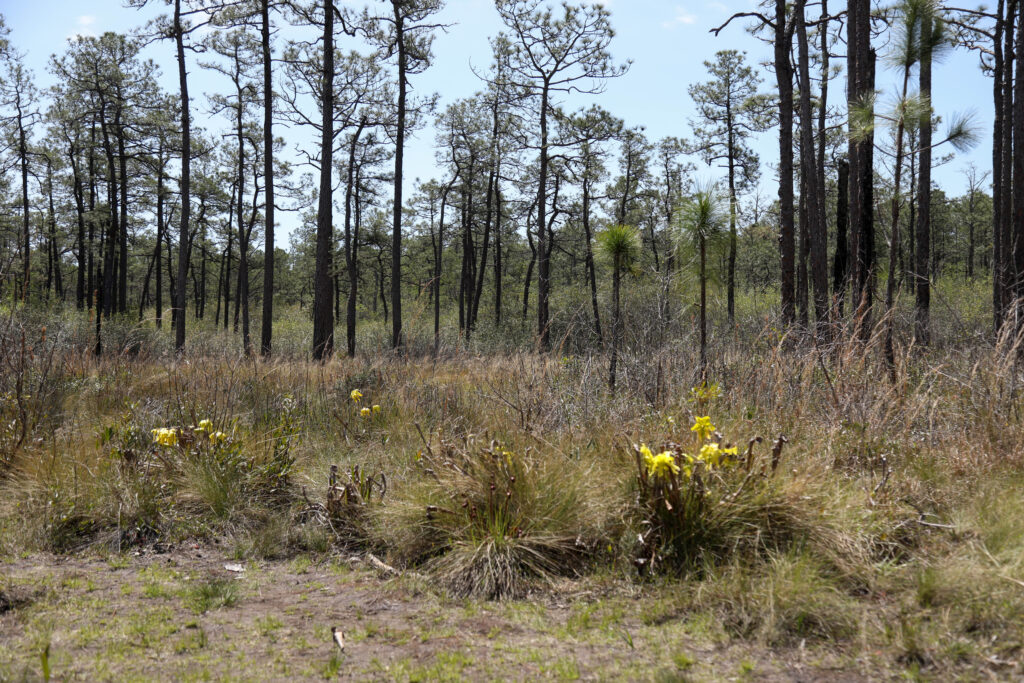
| What is a Carnivorous Plant? This is a little more complicated than it first appears. There are the obvious types of carnivorous plants, such as the ones described below. These effectively trap, digest, and absorb the nutrients from the critters they capture. But there are also protocarnivorous plants. These can effectively snare insects but do not have the ability to digest or absorb them. So, the question is, what is the purpose of ensnaring small organisms if they cannot be consumed (I realize this has an anthropocentric utilitarian slant). One of the suggestions is that these plants are on the evolutionary path toward being fully carnivorous. There is some interesting science to back up this concept. All the flowers from these carnivorous plants are held relatively high above the ground and away from the entrapping parts so they do not kill their pollinators. Most insect-eating plants grow in nutrient poor soils. Their carnivory apparently stems from trying to obtain additional nutritional sources. Some of the larger traps can capture small insects and spiders. Smaller traps (as with the Bladderwort) trap very small organisms such as nematodes and protozoa. |

Venus Flytrap (Dionaea muscipula, Droseraceae)
This is the plant that I went to visit. I have long wanted to admire this unusual plant in its native habitat. Venus flytrap is distinctive as it has teeth-like appendages, giving it a more grizzly appearance (at least to me).
Both the common and botanical names are interesting. Flytrap is obvious, but why ‘Venus’? The most common theory is also the most bizarre. Follow me here. Venus is the goddess of love, and to some early botanists, the leaf trap of this plant looks like…female genitalia. I know, I know, but this is what most sources agree on for its origin. This website has the most thorough origin story I could find.
Dionaea means the ‘daughter of Dione,’ who is Aphrodite, another goddess of love. This is also likely due to the same comparison. Muscipula means ‘mousetrap,’ so that part is also obvious, though I don’t think they can munch on rodents (yet).
Even more interesting is how the plant traps its prey. There are sensitive trigger hairs inside the trap that close if a specific pattern is initiated. This is set up so the trap doesn’t close on raindrops or other non-edible phenomena. The goal of these traps is to avoid being easily triggered, as well as being to be able to close quickly capture edible critters that land on them. This is important as it takes about 12 hours for each trap to reopen. A distinctive pattern of coming into contact with these inner hairs helps the plant discern that edible prey has landed.
Once the hairs are triggered, the leaf-like structure quickly closes around the prey. At first, there is enough space between the teeth for a tiny insect to wiggle out. This is thought to be an energy-saving device by the plant, as the amount of chemicals and time needed to devour a small insect may be a poor use of its energy resources.
As the trapped insect moves around, the trap further tightens and begins to release digestive enzymes to break it down and absorb its nutrients. This takes about 10 days. After that, it opens again, with only the body’s hard parts (the chitin) left.
While these plants are commonly propagated and sold, they are also extensively gathered in the wild for sale. This has made them vulnerable and endangered. Please be cautious when visiting them.
The Green Swamp Preserve in North Carolina was the best place I saw these in their natural habitat.
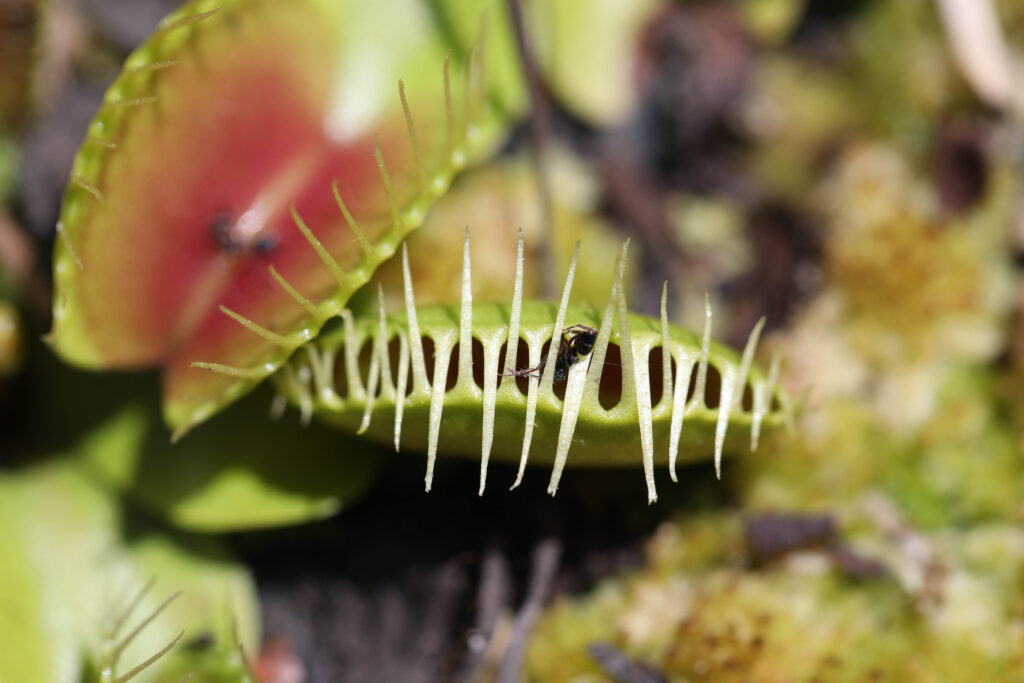

Sundew (Drosera capillaris, Droseraceae)
Sundews (Drosera species) are a much more common plant than Venus flytraps. They have a worldwide distribution with over 190 species. Its common name is much less lascivious than the Venus flytrap. It relates to the glistening quality of its leaves. And Drosera means ‘dewdrops.’
The leaves have sticky hairs that exude a sweet mucilage that attracts and captures small prey.
Once an insect is stuck in the hairs and struggling to escape, the leaf will bend around it, allowing more glandular hairs to come into contact with the insect’s body. They will then release enzymes to break down the insect and begin to absorb the nutrients for its body
They have small white flowers, which are held on a leafless stem above the entrapping leaves.
I often see Drosera species while sloshing around in swamps and bogs.


Pitcher Plant (Sarracenia species, Sarraceniaceae)
I saw 3 species of Pitcher plants (and one possible hybrid) while poking around the Carolina coast. These are intriguing plants with a unique way of trapping small prey. Unlike the previous carnivorous plants, they do not have any moving parts. Instead, they use a modified vase-shaped leaf. This is where the insects get trapped, drowned, and digested.
The modified pitcher-shaped leaves work through several mechanisms. First, they secrete nectar on their lip, which entices the insect to land. This part is slippery, which causes the insect to start to slide into the tube. Once inside, there are downward pointing hairs on the leaf, making it difficult to climb out (this will only work on small insects). They then fall into the liquid at the bottom of the funnel that contains digestive enzymes. In the end, only the exoskeleton is left behind.
Interestingly, some organisms are not affected by the fluid at the base, including certain insect larvae, protozoa, and fungi.


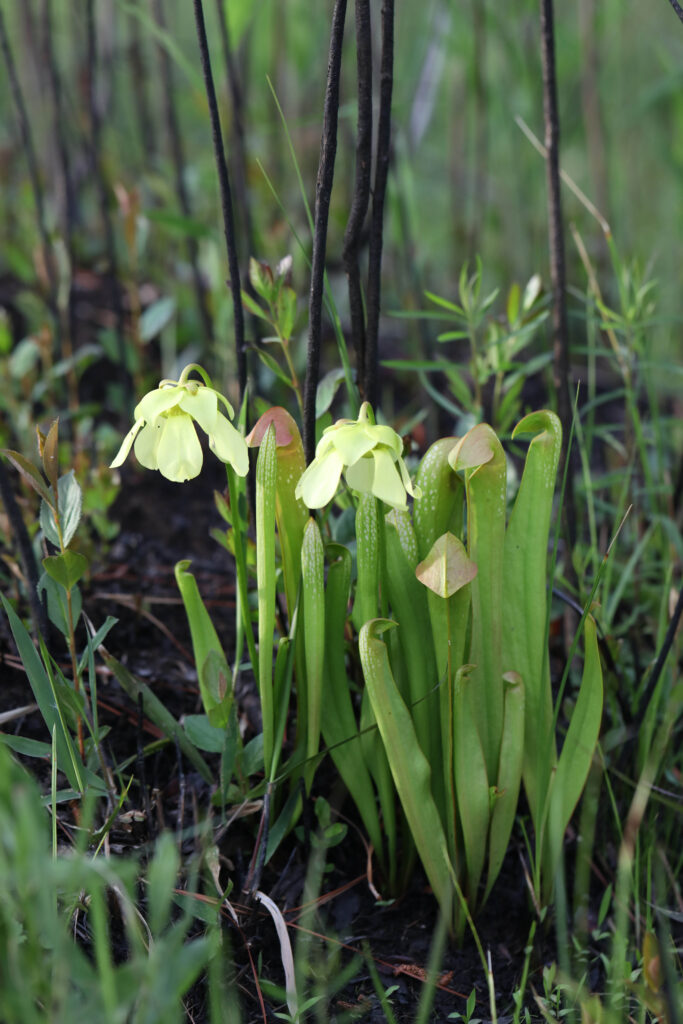

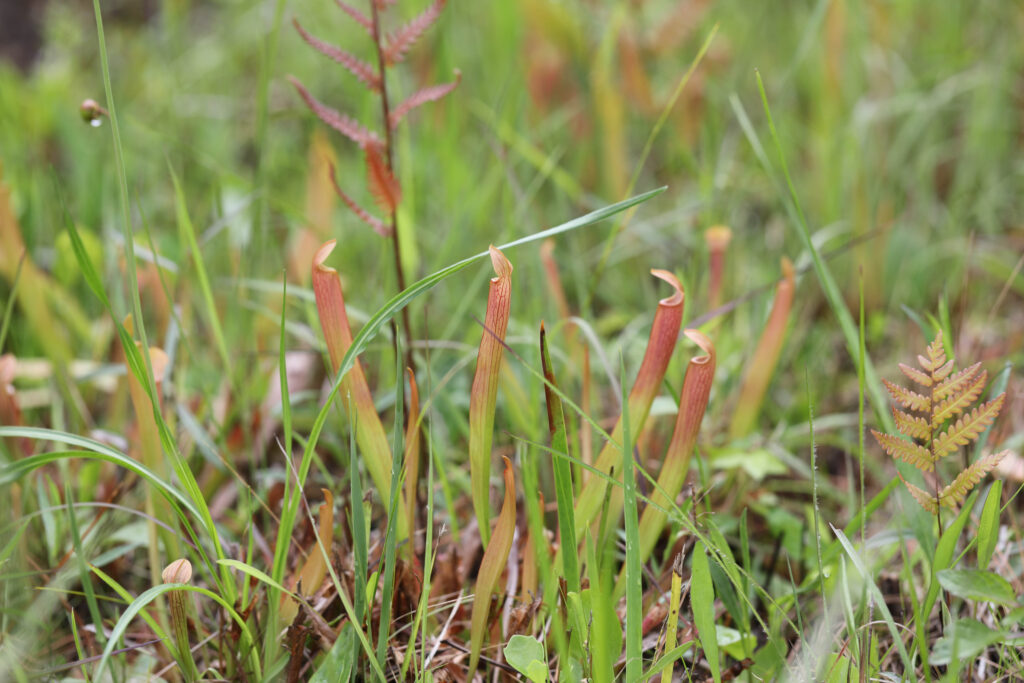
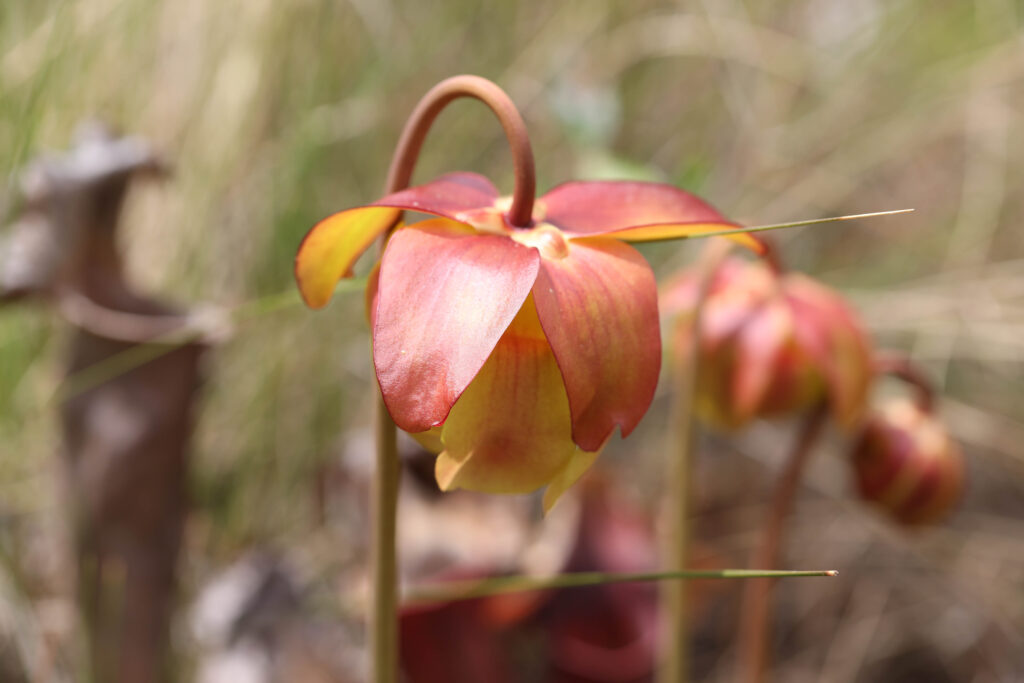
Blue butterwort (Pinguicula caerulea) and Yellow butterwort (Pinguicula lutea) (Lentibulariaceae)
Like Sundews, Butterworts have glandular secretions on their leaves, though they do not fold over their prey. They contain two main types of secretions. One type is sticky and ensnares insects that land on them. The other secretion is enzymatic to dissolve the insect’s body and absorb its nutrients.
The genus Pinguicula means ‘fat’ in Latin, and it has to do with the shiny surface of the leaves. This also leads to the name ‘Butterwort.’

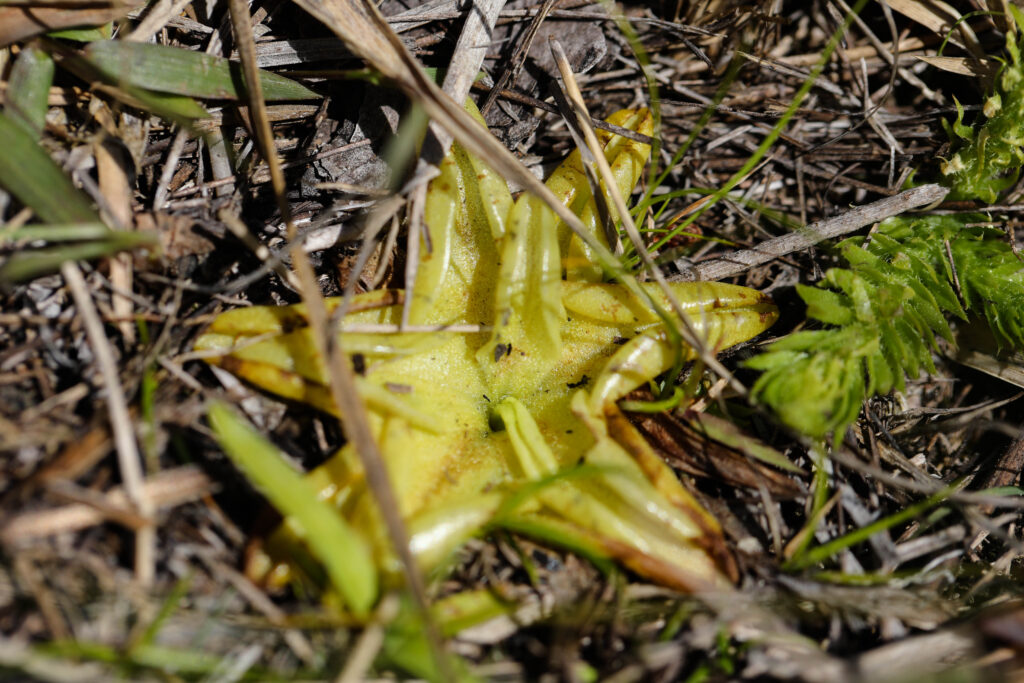
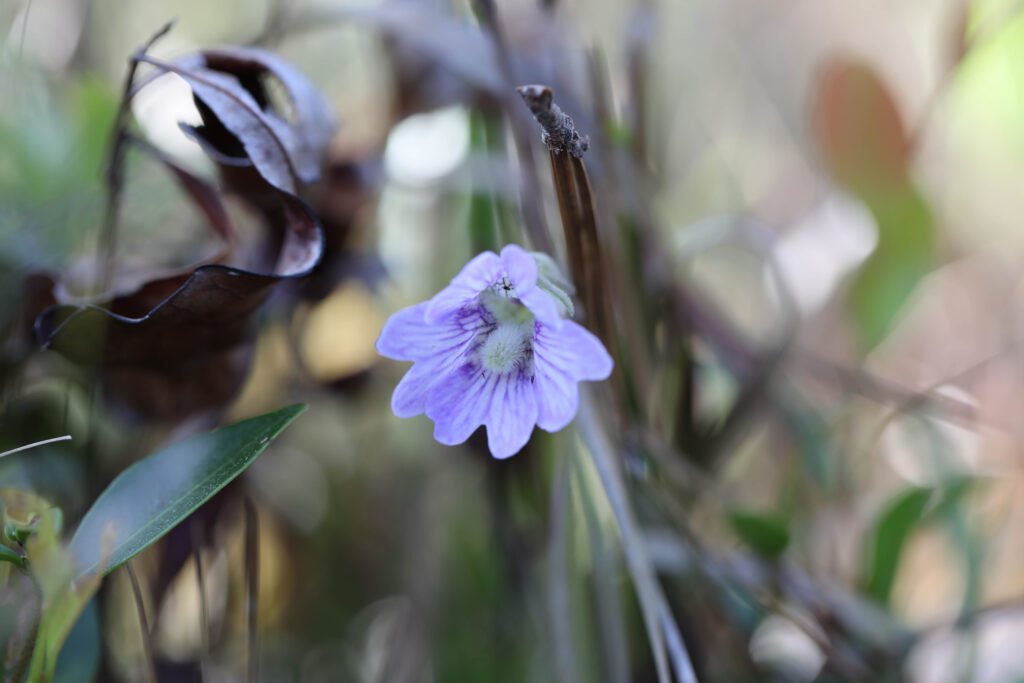
Zigzag bladderwort (Utricularia subulata, Lentibulariaceae)
The bladderworts have an entirely different way of entrapping and digesting prey. They are called ‘bladderworts’ because their traps are small hollow structures like a bladder. In terrestrial species, including this species, the bladder lies at the soil surface, ensnaring very small organisms such as protozoa.
It is fascinating how these traps work. They have a few trigger hairs attached to the outside of the bladder. When they are jostled, they cause the door of the trap to suddenly open up, taking in the prey and the water it was swimming in. This is done by suction. As they open up, all the nearby water and prey are taken into the bladder, which quickly closes. This happens in about one-hundredth of a second (10 milliseconds).
Once inside, digestive enzymes are secreted, and the water is pumped out of the bladder. After the water is pumped out, the vacuum is once again created inside the bladder trap, and it can capture more prey.
Utricularia species are found worldwide in suitable environments.


Final Notes
There is something intriguing about plants that can eat small organisms. If you find carnivorous plants interesting, I suggest further research, as this article only begins to describe the complexity of these plants. ~7Song

